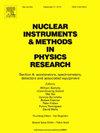JNE选矿厂的研制与表征
IF 1.5
3区 物理与天体物理
Q3 INSTRUMENTS & INSTRUMENTATION
Nuclear Instruments & Methods in Physics Research Section A-accelerators Spectrometers Detectors and Associated Equipment
Pub Date : 2025-06-24
DOI:10.1016/j.nima.2025.170755
引用次数: 0
摘要
为了提高JNE探测器的有效覆盖范围,在每个PMT上安装定制设计的光聚光器是一种实用且经济的方法。选取截止角为70°的浓缩器,测量了浓缩系数在空气介质中四个波长的角响应。测量结果与蒙特卡罗模拟结果一致。此外,我们的研究结果表明,在平行照明条件下,这些聚光器可以提高40%的光收集效率。这种增强导致传输时间扩展略有增加,一半最大全宽度(FWHM)增加不到0.3 ns。研究结果表明,所研制的光聚焦器非常适合于JNE。本文章由计算机程序翻译,如有差异,请以英文原文为准。
Development and characterization of the JNE concentrator
The Jinping Neutrino Experiment (JNE) will utilize approximately 3000 8-inch MCP-PMTs identified as GDB-6082 from North Night Vision Technology to detect neutrinos. To enhance the effective coverage of the JNE detector, mounting a custom-designed light concentrator on each PMT is a practical and economical approach. We measured angular responses of the concentration factor at four wavelengths in air medium for the concentrator with the selected cutoff angle of 70°. The measurements align with the Monte Carlo simulations. Furthermore, our results indicate that these concentrators can improve the efficiency of light collection by 40% under parallel illumination conditions. This enhancement results in a slight increase in transit-time spread, with the full width at half maximum (FWHM) increasing by less than 0.3 ns. We conclude that the developed light concentrators are highly suitable for the JNE.
求助全文
通过发布文献求助,成功后即可免费获取论文全文。
去求助
来源期刊
CiteScore
3.20
自引率
21.40%
发文量
787
审稿时长
1 months
期刊介绍:
Section A of Nuclear Instruments and Methods in Physics Research publishes papers on design, manufacturing and performance of scientific instruments with an emphasis on large scale facilities. This includes the development of particle accelerators, ion sources, beam transport systems and target arrangements as well as the use of secondary phenomena such as synchrotron radiation and free electron lasers. It also includes all types of instrumentation for the detection and spectrometry of radiations from high energy processes and nuclear decays, as well as instrumentation for experiments at nuclear reactors. Specialized electronics for nuclear and other types of spectrometry as well as computerization of measurements and control systems in this area also find their place in the A section.
Theoretical as well as experimental papers are accepted.

 求助内容:
求助内容: 应助结果提醒方式:
应助结果提醒方式:


